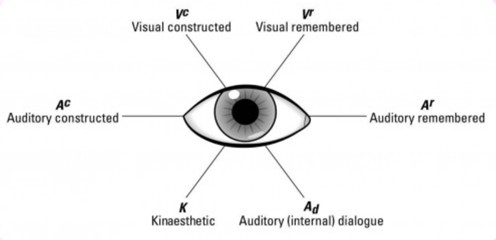We have heard for a long time that: Eyes do not lie. Is this scientifically correct?
In this article, we are going to look at this issue from the perspective of Neuro-Linguistic Programming.
Due to the fact that the place where information is stored and how to access it, as well as their neural pathways in the brain are different, the direction of movement of the eyes while accessing them will also indicate the type of information.

You can use this point to recognize someone lying to you, to recognize how someone feels about you, to recognize what kind of data the other person is thinking about.
Note that the directions, such as the bottom left, refer to when you are standing in front of a person and his eye is tilted to your left. So if you want to test these directions on yourself, you have to reverse them.

Look at this picture. As shown in the figure, in a general category, looking up means accessing Visual Data.
The middle line represents Auditory information, and the lower part includes Self Talk and Kinaesthetic emotions (such as remembering the amputation of hands, cold, etc.).
The indices r and c refer to the two words Remembered and Constructed. In the following, I will give a more detailed explanation of the figure above.
Figure Description
Eyes Looking up and to the left (Vc)
Again the subject is accessing the visual information and imagining an image, but the image does not exist in his mind and he is making the corresponding image. The person is seeing new and different images.
Eyes Looking to the right (Ar)
The subject is accessing the audio information he has already heard. For example, he remembers the voice of one of his friends who said a sentence to him.
Eyes Looking to the left (Ac)
The subject is listening to new and different sounds in his mind that he has never heard before.
Looking down and right (Ad)
The subject is talking to himself.
Looking down and to the left
The subject is accessing emotional information. Such as feelings, touch, burning sensation, and so on. Or like remembering an injury or pain. It can also express feelings of love or hate. Example: What do you think of him? If the person’s gaze is transferred to the Kinaesthetic section, it will indicate a feeling of interest or hatred. (To distinguish between the two, pay attention to body language, facial expressions, and other signals.)
Eyes fixed on one point
Seeing new images in the mind and observing them.
Important Points
- The above rules are true in the majority of people, but in some people, the left and right directions (not up and down) are seen in exactly the opposite way. It is recommended that you first ask the person questions on a trial basis (for example, first ask them about a sensory memory and then find out where they are looking) so that you can understand the person’s direction for the Kinaesthetic channel and then Identify the rest.
- To detect a lie, you can pay attention to whether it is Remembered or Constructed. If the relevant memory occurs, it must also be verified by the person looking at the Kinaesthetic or Vr or Ar channel (depending on the type of data you have asked the person).
- Here’s an interesting tip for remembering the information you forgot: You can also use this article for photos. Example :
Do you try to remember the voice of the person and the sentence you were told but forgot? To remember better, first, turn your eyes to the Ar channel and then think again so that the neurological pathways can help you remember the event better. - Given Heisenberg’s uncertainty principle, the results will not be accurate if the subject knows that his gaze is being controlled. In these cases, the conscientious part of the other person should be diverted first and then the looks should be analyzed.






